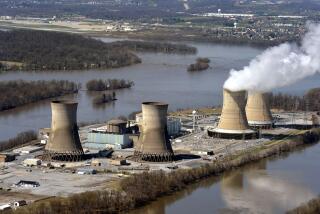San Onofre nuclear power plant prohibited from restarting
The U.S. Nuclear Regulatory Commission, citing serious concerns about equipment failures at the San Onofre nuclear power plant, has prohibited Southern California Edison from restarting the plant until the problems are thoroughly understood and fixed.
The plant has been shut down for two months, the longest in San Onofre’s history, after a tube leak in one of the plant’s steam generators released a small amount of radioactive steam. Since then, unusual wear has been found on hundreds of tubes that carry radioactive water.
Neither regulators nor Edison have said when they believe the plant will reopen. San Onofre is a major supplier of power for Southern California, producing about 2,200 megawatts of power, or enough electricity to serve 1.4 million households. It is Southern California’s only nuclear power plant.
State officials are already working on contingency plans to avoid power outages during the summer months if the plant remains out of commission. They are considering transmission upgrades, bringing back retired generating units at a natural gas plant in Huntington Beach and launching new conservation efforts, including flex-alerts to encourage customers to use less energy.
Until now, the cause of the tube problems had been a mystery. But in a letter federal regulators sent to Edison on Tuesday, officials said tubes were vibrating and rubbing against support structures and adjacent tubes.
According to the NRC, the tubes in Unit 3 were rubbing against each other and against the support structures, while those in Unit 2 were rubbing against the support structure but not against each other. Commission spokeswoman Lara Uselding said the root cause of the issue is still unclear.
The NRC letter prohibits Edison from restarting the plant until regulators believe the problems have been addressed and San Onofre is safe to operate.
“Until we are satisfied that has been done, the plant will not be permitted to restart,” NRC Region IV Administrator Elmo E. Collins said in a statement.
Although the NRC had ordered nuclear plants shut down before, the move is considered a significant step that signals the plant is unsafe to operate.
The problems are perplexing because the steam generators were installed within the last two years at a cost of $671 million to be paid by Edison and San Diego Gas & Electric customers through higher rates. The new equipment was intended to last until the plant’s license expires in 2022.
Officials said the wear on the tubes was unusual for such new equipment.
The situation posed a safety threat for two reasons. The rupture of tubes can release radiation. Moreover, if many tubes were to rupture at one time, it could compromise the cooling system of the reactor’s core.
In Unit 3, a total of eight tubes failed pressure tests in recent weeks. In Unit 2, 192 tubes — about 1% of the unit’s total — showed signs of wear and were taken out of service.
Typically, a steam generator can operate at full power with about 8% of its tubes out of service and some have operated with up to 30% out of service, Uselding said.
Under the terms of the letter issued Tuesday, before the plant can return to service, Edison must determine what is causing the tubes in Unit 3 to rub against each other and ensure that the same thing does not happen in Unit 2. It also must complete pressure testing of tubes with possibly excessive wear and take those that show too much deterioration out of service, and it must develop a schedule of added inspections once the plant returns to service.
Edison said it is committed to meeting the NRC’s requirements.
“Our No. 1 priority is, and always has been, the health and safety of the public and our employees,” said Southern California Edison President Ron Litzinger in a company statement. “The utility will only bring the units on line when we and the NRC are satisfied that it is safe to do so.”
Also Tuesday, an advocacy group released a report alleging that design flaws in the newly installed steam generators contributed to the problems.
The report was commissioned by Friends of the Earth and prepared by consultant Arnie Gundersen of Fairewinds Associates, a former nuclear industry executive who is now a critic of the industry. The report alleges that design changes — including a different alloy used to make the tubes, a change in the flow rate, addition of more tubes and changes in the support structures that hold the tubes in place — probably caused the unexpected wear.
The generators were manufactured by Mitsubishi Heavy Industries.
One other nuclear plant in the United States, Fort Calhoun Nuclear Generating Station in Nebraska, uses steam generators made by Mitsubishi. But Uselding said the design of the San Onofre generators is unique, and Fort Calhoun has not experienced the same issues.
Patrick Boyle, a spokesman for Mitsubishi, said the company considers the tube wear to be “a serious matter” and is supporting Edison in finding the root cause.
More to Read
Sign up for Essential California
The most important California stories and recommendations in your inbox every morning.
You may occasionally receive promotional content from the Los Angeles Times.











